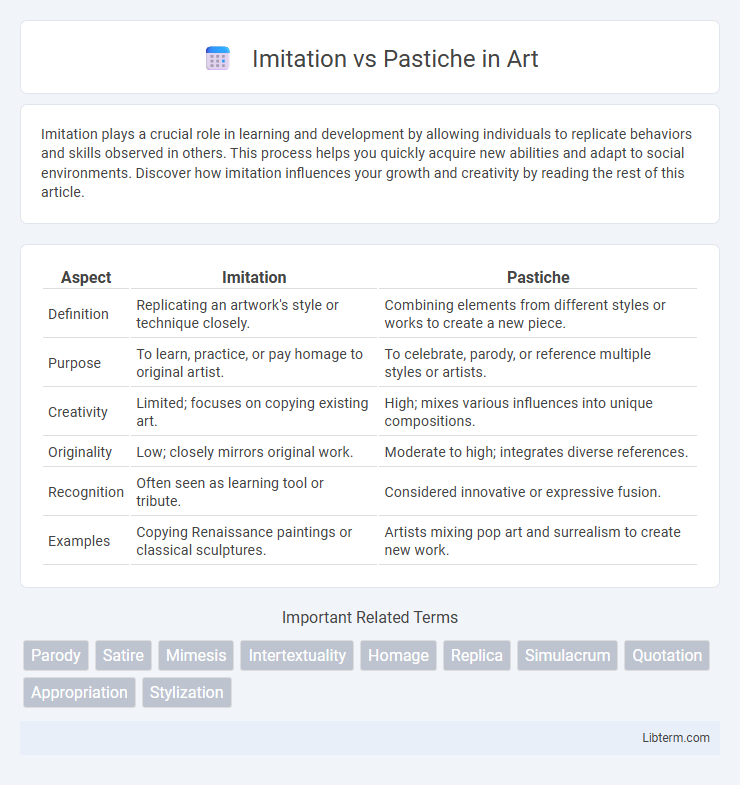Imitation plays a crucial role in learning and development by allowing individuals to replicate behaviors and skills observed in others. This process helps you quickly acquire new abilities and adapt to social environments. Discover how imitation influences your growth and creativity by reading the rest of this article.
Table of Comparison
| Aspect | Imitation | Pastiche |
|---|---|---|
| Definition | Replicating an artwork's style or technique closely. | Combining elements from different styles or works to create a new piece. |
| Purpose | To learn, practice, or pay homage to original artist. | To celebrate, parody, or reference multiple styles or artists. |
| Creativity | Limited; focuses on copying existing art. | High; mixes various influences into unique compositions. |
| Originality | Low; closely mirrors original work. | Moderate to high; integrates diverse references. |
| Recognition | Often seen as learning tool or tribute. | Considered innovative or expressive fusion. |
| Examples | Copying Renaissance paintings or classical sculptures. | Artists mixing pop art and surrealism to create new work. |
Understanding Imitation and Pastiche
Imitation involves replicating the style or techniques of an original work to learn or pay homage, often used in artistic practice for skill development. Pastiche, by contrast, combines elements from multiple sources or styles to create a new, often playful or satirical, composition that highlights its derivative nature. Understanding the distinction helps to identify intent--imitation aims at faithful reproduction, while pastiche embraces collage-like synthesis and commentary.
Historical Contexts of Imitation and Pastiche
Imitation in historical contexts often served as a method for artists and writers to learn from classical masters by replicating styles and techniques, reinforcing cultural heritage and continuity. Pastiche emerged prominently in postmodern periods as a deliberate blending of multiple styles, reflecting a more playful or ironic homage to past works rather than strict replication. The evolution from imitation to pastiche highlights shifts in artistic intentions and cultural attitudes toward originality and historical reference.
Defining Key Differences
Imitation involves replicating a specific style or work to understand or pay homage, maintaining close fidelity to the original's techniques and themes. Pastiche blends multiple styles or elements from different sources, creating a new work that celebrates its influences without strict adherence to one. The key difference lies in imitation's emphasis on mirroring a single source, whereas pastiche intentionally fuses diverse styles for a novel, composite effect.
Artistic Intentions Behind Each Approach
Imitation involves replicating a style or artwork to master techniques and gain a deeper understanding of the original artist's methods, often serving educational or appreciative purposes. Pastiche combines elements from various sources to create a new, often celebratory or critical composition, emphasizing creativity and reinterpretation rather than replication. The artistic intention behind imitation centers on preservation and learning, while pastiche aims to innovate, comment, or pay homage within a broader cultural or artistic context.
Imitation in Art and Literature
Imitation in art and literature involves closely replicating the style, techniques, or themes of a particular artist or writer to study or pay homage to the original work. This practice serves as a foundational method for developing creative skills by internalizing established forms and methods, fostering deeper understanding and innovation. Imitation also functions as a deliberate artistic strategy to evoke or critique historical contexts, blending tradition with contemporary expression.
Pastiche as Creative Expression
Pastiche functions as a creative expression by blending multiple stylistic elements from various sources to generate a unique artistic work, often celebrating rather than mocking the originals. Unlike mere imitation, pastiche embraces innovation through homage, allowing artists to explore new meanings and cultural dialogues within familiar aesthetic frameworks. This technique enriches contemporary art and literature by fostering intertextuality and dynamic reinterpretation.
Benefits and Drawbacks of Imitation
Imitation allows artists to learn technical skills and understand stylistic nuances by closely replicating established works, fostering skill development and deeper artistic insight. However, excessive reliance on imitation can limit creativity, leading to a lack of originality and personal expression. Balancing imitation with innovation is crucial to avoid producing derivative art that fails to contribute new perspectives.
The Role of Pastiche in Postmodernism
Pastiche plays a crucial role in postmodernism by deliberately blending and replicating diverse styles, genres, and cultural elements to challenge traditional notions of originality and authorship. Unlike mere imitation, pastiche employs this collage of references to reflect on the fluidity of meaning and the constructed nature of cultural texts. This technique underscores the postmodern critique of grand narratives, highlighting irony, playfulness, and the coexistence of multiple interpretations in contemporary art and literature.
Cultural Impact of Imitation vs Pastiche
Imitation and pastiche play distinct roles in cultural expression, with imitation often serving as a foundational method for learning and preserving traditional art forms, thereby maintaining cultural continuity. Pastiche, on the other hand, merges multiple stylistic elements from various sources, reflecting postmodern cultural dynamics and fostering innovation through the blending of different cultural references. These practices influence how societies perceive authenticity and creativity, shaping cultural identity and artistic evolution in contemporary contexts.
Choosing Between Imitation and Pastiche
Choosing between imitation and pastiche hinges on the intent and creative goals of the artist; imitation seeks to replicate the original style or work closely, emphasizing technical accuracy and homage, while pastiche combines multiple elements from different sources to create a new, often celebratory composition. Imitation is ideal for learning techniques or preserving traditional styles, whereas pastiche suits innovative projects that blend influences without aiming for exact replication. Understanding the distinction helps artists and critics evaluate authenticity, creativity, and purpose in artistic expression.
Imitation Infographic

 libterm.com
libterm.com